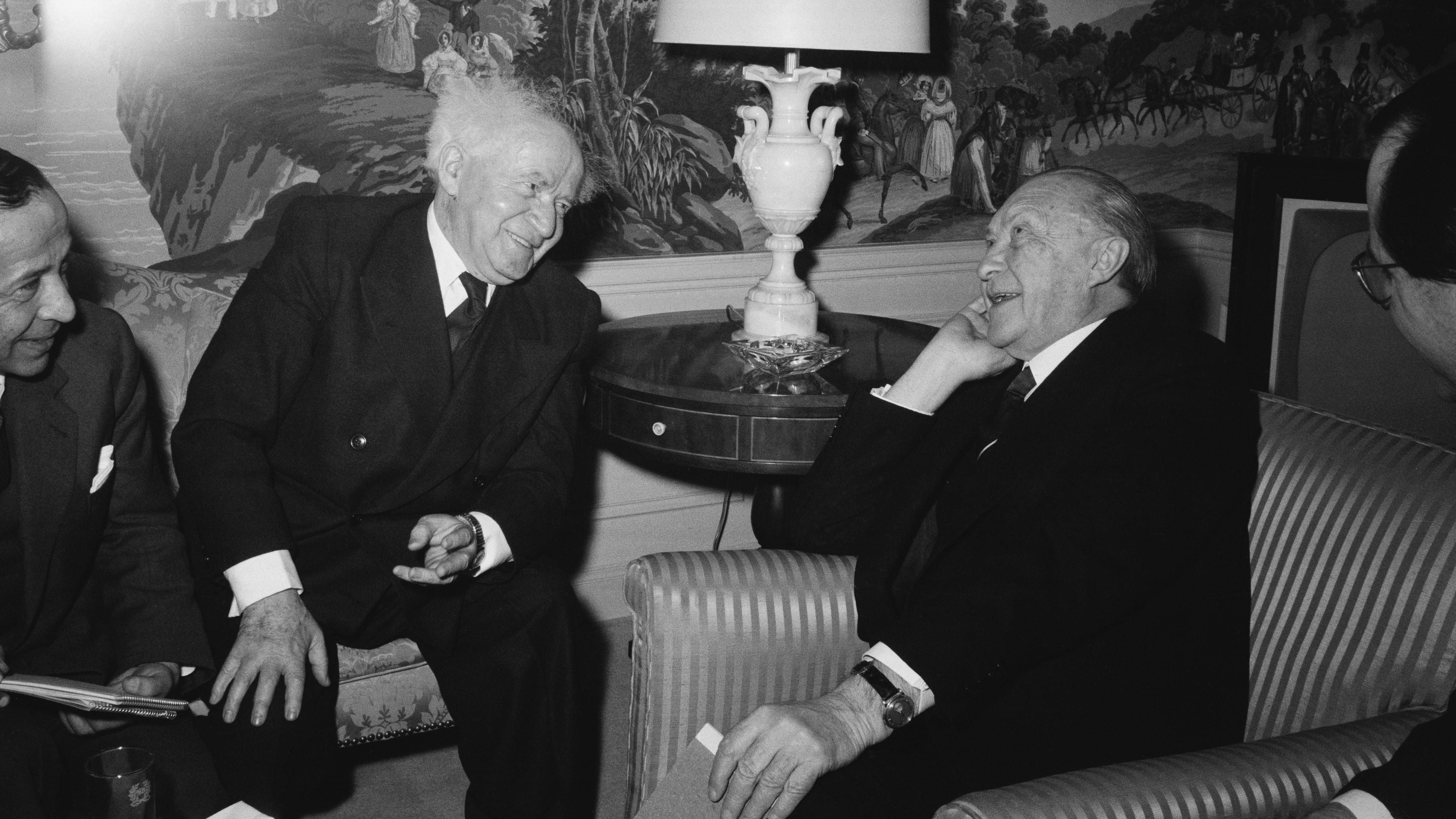Background information
In addition to operating government-funded compensation programs for decades, Germany signed an Executive Agreement with the United States in 2000 that was meant to fully address and finally resolve all compensation issues for Nazi-regime victims. German insurance companies participated in this effort by providing more than 281 million euros to the funding of the Foundation “Remembrance, Responsibility and Future” (Stiftung Erinnerung, Verantwortung und Zukunft, or EVZ) in Germany and by participating in the global ICHEIC process.

before 1945
PLUNDER OF ASSETS AND PERSECUTION: Between 1933 and 1945 Jewish properties and assets – including insurance policies – were looted in unprecedented manner by the Nazis. Post-war Germany accepted responsibility for the crimes of the Nazi regime and has provided reparations and other compensation to the present day. In 1933 approximately 550,000 Jewish citizens lived in Germany. Although approximately 250,000 were able to emigrate by 1939, most of them lost their properties and assets, including insurance policies. Policy assets were either confiscated directly from the policyholders or required to be paid by the insurers into “blocked accounts” that could only be accessed by the Nazi government.

Since 1952
COMPENSATION:
Under the 1952 “Luxembourg Agreement”, the Federal Republic of Germany agreed to provide compensation to the State of Israel. Since the 1950s, several German laws – in particular the “Bundesentschädigungsgesetz“ (the “Federal Law for the Compensation of the Victims of National Socialist Persecution”, or BEG) – have also provided for individual restitution to Holocaust victims for personal damages and losses, including unpaid or confiscated insurance policies. The total compensation amount paid for insurance policies through these programs cannot be determined, since the individual compensation amounts paid to each recipient combined numerous different asset classes (e.g., compensation for life and personal damages, health, liberty, properties, and financial assets).
In this picture: In 1960 David Ben-Gurion, Israel’s first prime minister, met German chancellor Konrad Adenauer in New York’s Waldorf Astoria hotel.

1998-2007
EXECUTIVE AGREEMENT AND ICHEIC PROCESS:
In 2000, the United States and Germany signed an Executive Agreement under which all German companies would be entitled to legal peace regarding lawsuits filed in the United States related to Holocaust compensation claims. In exchange, the newly created German Foundation “Remembrance, Responsibility, and Future” (i.e. “Stiftung Erinnerung, Verantwortung und Zukunft, or EVZ) provided substantial additional recompense to forced laborers and for Jewish citizens’ seized bank accounts and insurance policies. To implement this Executive Agreement, the global acting “International Commission on Holocaust Era Insurance Claims” (ICHEIC), the Foundation EVZ, and the German Insurance Association (GDV) agreed in 2002 to establish an additional process for the compensation of those German insurance policies of Jewish policyholders that had not been addressed by previous German government-funded compensation programs. The American-German Executive Agreement and the ICHEIC process were meant to serve as the definitive framework for the compensation of Holocaust victims and their heirs. The ICHEIC process ended in 2007 with the consent of all involved parties from the U.S., Israel, and Jewish organizations.
In this picture: U.S. special envoy Stuart Eizenstat, German Chancellor Gerhard Schröder, and the head of the German delegation Otto Graf Lambsdorff after the signing of the Executive Agreement.

SINCE 2007
ADDITIONAL VOLUNTARY PROCESSING:
Since the conclusion of the ICHEIC process, German insurance companies have continued to review all new inquiries regarding unpaid insurance policies from the Holocaust era, and to honor legitimate claims on a voluntary basis.
Legal Peace due to Executive Agreement
The fall of the Iron Curtain, the reunification of Germany, and the end of communism propelled a new debate regarding the compensation of Holocaust victims from Central and Eastern Europe in particular. Initially this discussion primarily focused on compensation for forced laborers and Swiss bank accounts. Subsequently it was expanded to encompass once again the issue of Jewish policyholders’ unpaid or confiscated insurance policies. To address all of these concerns, the United States and Germany signed a comprehensive Executive Agreement in the year 2000 that was meant to serve as the definitive settlement for Holocaust victims. It established legal peace for all German companies regarding from all future Holocaust-era claims in the United States and committed the newly created Foundation “Remembrance, Responsibility, and Future” (i.e. “Stiftung Erinnerung, Verantwortung und Zukunft, or EVZ) to providing additional compensation for Jewish victims of the Holocaust and their heirs in the amount of 5 billion euros.
The Foundation “Remembrance, Responsibility, and Future” (“Stiftung Erinnerung, Verantwortung und Zukunft”, or EVZ)
One commitment stipulated in the Executive Agreement between the United States and Germany was the creation of the Foundation “Remembrance, Responsibility, and Future” (“Stiftung Erinnerung, Verantwortung und Zukunft”, or EVZ) in Germany. The Foundation EVZ’s compensation fund of 5.1 billion euros was established in equal share by the German government and the private sector. The German insurance industry contributed more than 281 million euros. The primary purpose of the Foundation EVZ was to provide compensation for forced labor under the Nazis, confiscated bank accounts held by Jewish citizens, and unpaid and previously uncompensated insurance policies held by Jewish policyholders. The EVZ compensation program was concluded in 2007 with the consent of the governments of the U.S. and Israel, and numerous Jewish organizations. The Foundation EVZ continues to support projects that promote human rights and international understanding and to commemorate victims of Nazi injustice with a specially designated funding stream.
ICHEIC and Insurance Policies
The ICHEIC (International Commission on Holocaust Era Insurance Claims) was established in 1998 by U.S. insurance regulators, the State of Israel, Jewish organizations, and European insurance companies. Former U.S. Secretary of State Lawrence Eagleburger served as the commission’s chairman. The ICHEIC established a global process for identifying and compensating unpaid and previously uncompensated insurance policies held by victims of the Holocaust. In 2002, the ICHEIC, the German Foundation EVZ, and the GDV signed a “Trilateral Agreement” under which they cooperated in the compensation of any insurance policies held by Jewish policyholders in Germany that had not already been addressed by previous government-funded compensation programs. The Trilateral Agreement contained specific stipulations regarding the claims-handling process for participating insurance companies; succession guidelines; standards of proof; a two-layer (peer-)review audit process for insurance companies conducted by the German state regulator (BaFin) and Jewish observers; the publication of the names of potential former policyholders; a process for matching public and company archives; and a detailed appeals process with independent arbiters in London to verify the companies’ decisions on submitted claims. When the ICHEIC concluded in 2007, German companies had contributed more than 281 million euros through the framework provided by the ICHEIC and the Foundation EVZ. Worldwide, the ICHEIC process distributed 306 million dollars to Holocaust survivors and their heirs for unpaid and previously uncompensated insurance policies.
The ICHEIC process – Numbers and Figures
-
Approximately 300 million dollars
in total have been paid out by German insurance companies via the ICHEIC process, of which approximately 102 million dollars were paid to eligible former Jewish policyholders or their heirs; and approximately 198 million dollars were donated to Jewish organizations for general humanitarian purposes.
-
132,000
claims for compensation of confiscated or unpaid insurance policies were filed with the ICHEIC between 1998 and 2007, of which approximately 91,000 were eligible.
-
19,421
of the approximately 91,000 eligible claims were filed for in the German market, while the remainder were designated for other countries that participated in the ICHEIC process.
-
86,247
individual names were included in 19,421 claims for the German market and were reviewed within the ICHEIC compensation process to verify their eligibility.
-
8,664
persons out of the 86,247 individuals named in claims were eligible to receive compensation for previously uncompensated insurance policies; for all remaining persons, either the existence of an insurance policy could not be established or the policy had already been compensated by previous government-funded compensation programs.
The total number of insurance policies held by Jewish policyholders in Germany cannot be ascertained because corporate records – insofar as they still exist beyond wartime destruction and statutory retention periods – generally do not identify a policyholder’s religion.